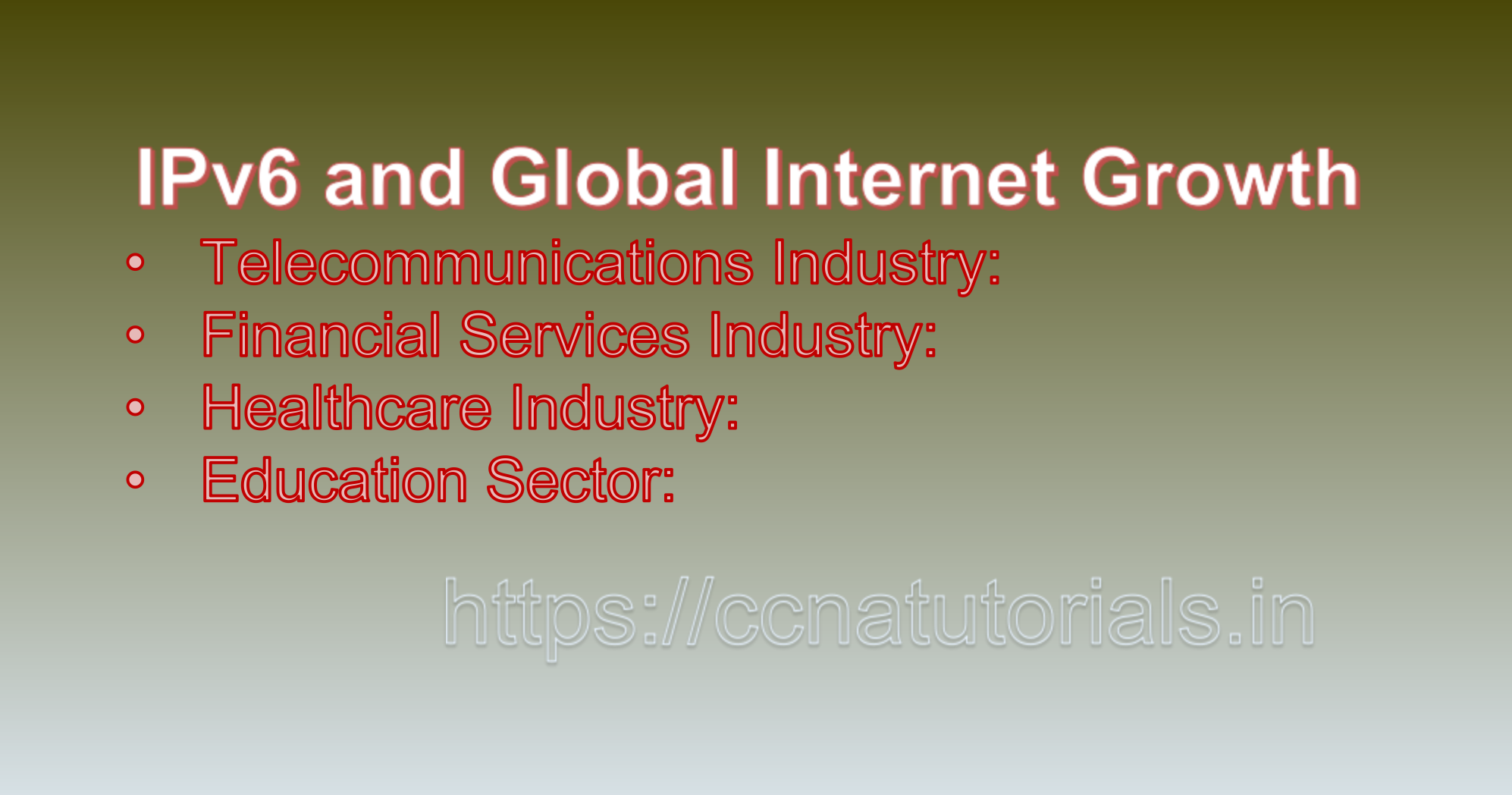Contents of this article
In this article, I describe IPv6 Case Studies in Industries: Embracing the Future of Networking. The adoption of Internet Protocol version 6 (IPv6) is a crucial step for various industries to accommodate the growing number of internet-connected devices and services. IPv6 offers an expansive address space, improved security features, and enhanced network efficiency. As industries transition to IPv6, they encounter unique challenges and opportunities that impact their operations. This article presents IPv6 case Studies in Industries, highlighting how organizations across various sectors have successfully implemented IPv6 to address their specific needs and reap the benefits of the new protocol.
1. Telecommunications Industry:
Case Study: Leading Telecommunication Provider’s IPv6 Implementation
A prominent telecommunications provider recognized the need to support the increasing number of devices on its network, including smartphones, IoT devices, and smart home appliances. To ensure seamless connectivity and future growth, the provider embarked on an IPv6 implementation.
Implementation:
– The telecommunications provider conducted a thorough assessment of its network infrastructure to identify IPv6 compatibility gaps.
– It upgraded its core routers, switches, and DNS servers to support IPv6.
– Dual stack deployment was chosen to enable coexistence of IPv4 and IPv6.
Benefits:
– The provider witnessed improved network efficiency due to the elimination of Network Address Translation (NAT) complexities.
– IPv6’s larger address space facilitated efficient device allocation and eliminated address scarcity concerns.
– The provider positioned itself for the era of 5G and IoT, enabling seamless connectivity for a plethora of devices.
2. Financial Services Industry:
Case Study: Global Bank’s IPv6 Implementation for Enhanced Security
A multinational bank recognized the need for improved network security and efficient communication between its branches across different regions. IPv6’s integrated security features presented an opportunity to enhance data integrity and authentication.
Implementation:
– The bank deployed IPv6 on its core infrastructure, including routers, firewalls, and intrusion detection systems.
– IPv6’s support for Internet Protocol Security (IPsec) was leveraged to establish secure communication channels between branch offices.
Benefits:
– Enhanced security was achieved through IPsec, ensuring encrypted and authenticated data transmission.
– IPv6’s simplified header structure reduced overhead and optimized network performance.
– The bank improved communication between global branches, promoting collaboration and streamlined operations.
3. Healthcare Industry:
Case Study: Hospital Network’s IPv6 Implementation for IoT Devices
A hospital network faced the challenge of managing an increasing number of IoT medical devices while ensuring patient data security. IPv6’s address space and security features were crucial in addressing these concerns.
Implementation:
– The hospital’s IT team implemented IPv6 to allocate unique addresses to each IoT medical device.
– IPv6’s security features, such as IPsec, were configured to protect patient data transmission.
Benefits:
– IPv6’s larger address space accommodated the growing number of IoT devices without address exhaustion concerns.
– IPsec ensured encrypted communication between devices, preserving patient data confidentiality.
– The hospital improved patient care by effectively managing and securing its IoT medical devices.
4. Education Sector:
Case Study: University’s IPv6 Implementation for Efficient Campus Networking
A university aimed to improve network efficiency, accommodate the increasing number of connected devices, and support research initiatives. IPv6’s hierarchical addressing and efficient routing capabilities were crucial in achieving these goals.
Implementation:
– The university adopted IPv6’s hierarchical addressing, allowing efficient subnetting and organization of devices.
– IPv6’s optimized routing header structure was leveraged to enhance network routing and reduce latency.
Benefits:
– Hierarchical addressing facilitated efficient management and troubleshooting of devices across the campus.
– IPv6’s improved routing efficiency resulted in reduced network congestion and latency.
– The university’s research initiatives were supported by seamless communication and robust network infrastructure.
5. Manufacturing Industry:
Case Study: Manufacturing Company’s IPv6 Integration for Factory Automation
A manufacturing company aimed to implement factory automation systems to enhance production efficiency. IPv6’s support for IoT and machine-to-machine communication played a pivotal role in achieving seamless automation.
Implementation:
– IPv6 was deployed to support IoT devices and facilitate machine-to-machine communication within the manufacturing plant.
– The company implemented IPv6-based communication protocols for real-time monitoring and control of production processes.
Benefits:
– IPv6-enabled factory automation streamlined production processes and reduced manual intervention.
– IoT devices and machines communicated efficiently through IPv6, improving overall production efficiency.
– The company achieved higher operational efficiency by embracing IPv6’s capabilities for automation.
6. Retail Industry:
Case Study: Retail Chain’s IPv6 Implementation for Enhanced Customer Experience
A retail chain recognized the importance of providing an enhanced customer experience through connected devices and smart shopping solutions. IPv6’s support for IoT devices and improved addressing played a key role in achieving this objective.
Implementation:
– The retail chain implemented IPv6 to enable seamless communication between IoT devices, such as smart shelves and checkout systems.
– IPv6’s address space allowed efficient allocation of addresses to IoT devices, ensuring scalability.
Benefits:
– IoT-enabled solutions enhanced the customer experience by providing real-time product information and personalized recommendations.
– IPv6’s address abundance facilitated the expansion of smart solutions without address scarcity concerns.
– The retail chain gained a competitive edge by leveraging IPv6’s capabilities to create a connected shopping environment.

In short Embracing IPv6’s Potential Across Industries
IPv6 is a transformative protocol that offers benefits across various industries. Whether in telecommunications, financial services, healthcare, education, manufacturing, or retail, IPv6 addresses the challenges posed by the proliferation of internet-connected devices and services. These case studies illustrate how organizations can harness the power of IPv6 to enhance security, streamline operations, improve connectivity, and position themselves for future growth. As industries continue to evolve and embrace digital transformation, IPv6 remains a foundational element in building resilient and efficient network infrastructures.
IPv6 Case Studies in Industries: Embracing the Future of Networking
The transition from Internet Protocol version 4 (IPv4) to Internet Protocol version 6 (IPv6) is a significant step for industries worldwide. IPv6’s expanded address space, enhanced security, and improved routing capabilities address the limitations of IPv4 and support the growing number of internet-connected devices. This article presents IPv6 case studies in various industries, showcasing how organizations have successfully adopted IPv6 to meet their unique needs and challenges.
1. Telecommunications Industry:
– Case Study: Major Telecom Provider: A prominent telecommunications company implements IPv6 to cater to the increasing demand for broadband services and IoT connectivity. By transitioning its core network to IPv6, the provider ensures that it has sufficient address space to accommodate millions of connected devices. This facilitates seamless communication and sets the stage for future service expansion.
2. Healthcare Industry:
– Case Study: Hospital Network: A hospital network adopts IPv6 to support its expanding range of medical devices, IoT-enabled equipment, and patient data exchange. By implementing IPv6, the network can accommodate the diverse set of devices and services required for efficient patient care. The enhanced security features of IPv6 safeguard sensitive patient information.
3. Financial Sector:
– Case Study: Banking Institution: A banking institution migrates to IPv6 to support its online banking services and mobile apps. IPv6 enables secure and efficient communication between the bank’s servers and customers’ devices, ensuring a seamless banking experience regardless of whether customers are using IPv4 or IPv6 networks.
4. Education Sector:
– Case Study: University Campus: A university implements IPv6 to meet the connectivity demands of its students, faculty, and researchers. With the adoption of IPv6, the university’s network can accommodate the growing number of devices, such as laptops, smartphones, and IoT devices, ensuring reliable and efficient communication across its campus.
5. Manufacturing Industry:
– Case Study: Manufacturing Plant: A manufacturing plant integrates IPv6 to improve the connectivity and communication between its production equipment and management systems. IPv6 enables real-time monitoring, remote management, and predictive maintenance of manufacturing processes, enhancing efficiency and reducing downtime.
6. Transportation and Logistics:
– Case Study: Global Shipping Company: A shipping company adopts IPv6 to enhance its tracking and logistics operations. IPv6 facilitates the communication between shipping containers equipped with IoT sensors and the central management system, ensuring accurate tracking and efficient delivery of goods.
7. Energy and Utilities:
– Case Study: Utility Provider: An energy utility company embraces IPv6 to modernize its smart grid infrastructure. IPv6 enables the seamless exchange of data between smart meters, distribution networks, and central control centers, enhancing the efficiency and reliability of energy distribution.
8. Entertainment and Media:
– Case Study: Media Streaming Platform: A media streaming platform deploys IPv6 to optimize the delivery of its content to a global audience. By adopting IPv6, the platform ensures efficient content distribution and improves user experience by reducing latency and enhancing network performance.
9. Government and Public Services:
– Case Study: Municipal Network: A city government migrates to IPv6 to support its smart city initiatives. IPv6 enables efficient communication among various smart devices and services, such as smart traffic lights, waste management systems, and public Wi-Fi networks, enhancing the overall quality of life for residents.
Conclusion for IPv6 Case Studies in Industries: Transforming Industries Through IPv6 Adoption:
IPv6 adoption is not limited to a specific industry; it spans across various sectors, from telecommunications to healthcare, education, finance, and more. These case studies demonstrate how IPv6 plays a pivotal role in addressing the challenges and demands of modern networking. As industries continue to evolve and innovate, IPv6 provides the foundation for secure, scalable, and efficient communication, ensuring that organizations can thrive in an increasingly connected world.






